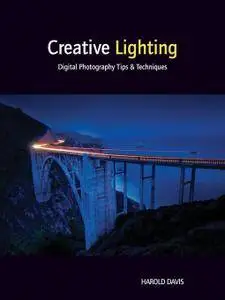Creative Lighting: Digital Photography Tips and Techniques by Harold Davis
English | 2011 | ISBN: 0470878231 | 256 pages | PDF | 44 MB
English | 2011 | ISBN: 0470878231 | 256 pages | PDF | 44 MB
How to make digital photography lighting more creative—and less challenging!
How do you master the art of lighting your photographs? Go beyond the basics, go beyond the "rules," and get creative with the help of renowned photographer Harold Davis. In this book, Harold shows you how to break the boundaries of conventional wisdom and create unique, lively, and beautifully lit photographs. Packed with tips and tricks as well as stunning examples of the author’s creativity, this book will both inform and inspire you to create your own lighting style.
Teaches you when and how to control the light in your photographs
Reviews the basic “rules” of digital photography lighting and shows you how to break the rules to create your own uniquely lit images
Helps you start building a lighting style of your own
Includes stunning examples of the author’s photography and lighting techniques
Whether you're a beginner or a seasoned digital photographer, you'll find ideas and techniques to spark your creativity.
Amazon.com Exlusive: Introduction Letter from the Author
Dear Amazon Readers,
Light is crucial to photography, and without lighting you cannot have a photo. But books about light and lighting come in a number of varieties. So if you are considering my book, I wanted to let you know why I wrote Creative Lighting: Digital Photography Tips & Techniques, where I am coming from in this book, and what you’ll find in it.
If there is one skill a photographer needs, it is the ability to see and understand light. Learning about the directionality, intensity, quality, and color of light is partly intuitive–but can largely be taught. Creative use of lighting makes or breaks a photo, whether the photo is shot outdoors or in the studio. Furthermore, you can’t even begin to understand how to create effective lighting until you learn to “read” light itself. Becoming familiar with light and lighting in all its infinite varieties is the first step along the way to mastering the craft of photography.
Creative Lighting covers both natural light and studio lighting. However, it is not a cookbook covering studio lighting setups; nor is it a book that emphasizes the pixels over the overall visual impact that a photograph can make. Each of the photos in this book can be used as idea generation for your own work–how you can use existing light, alter light, or create lighting to make spectacular photos of your own. I’ve included the story behind each photo in the book, as well as full technical data about the captures. The emphasis of my book is the creative use of lighting. Like other books in my Creative series, Creative Lighting is intended to be useful as an idea book.
Creative Lighting is conceptually divided into five parts. As you’ll see, there is a great deal of material, and it covers a lot of ground. The parts of Creative Lighting are:
Part I: Seeing the Light–Covers understanding and observing light and its characteristics (and applies to both studio and natural light); learning the material in this section is a first step towards becoming a master of light.
Part II: Exposure & Lighting–Details the responses to lighting in terms of camera settings because light and lighting is only one part of the exposure equation, the other side of the equation is how you set your camera to respond to the way the subject is lit.
Part III: Working with Ambient Light–Explains how to work with existing light, meaning sunlight and also mixed lighting environments, and also provides some tips for improving the quality of ambient and existing light.
Part IV: Lighting in the Studio–Shows you how to make creative use of continuous lights in still life compositions, and how to create stunning portraits using strobes in the studio.
Part V: Lighting in the Digital Darkroom—With digital photography, taking the photo is just the first part of the workflow. In this section, you’ll learn to use RAW processing and Photoshop to improve the creative impact of lighting in post-processing, and even change the entire lighting effect in a photo.



